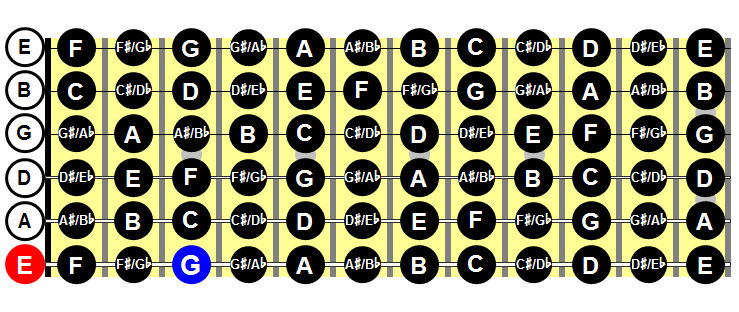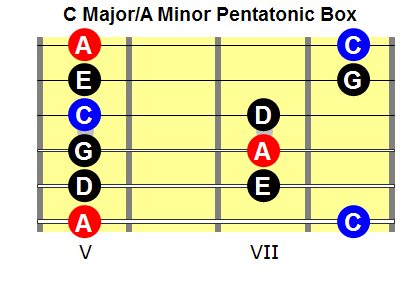Relative major and minor pentatonic scales relate to each other in the same way that relative major and minor scales relate to each other.
Every major pentatonic scale has a relative minor pentatonic scale that shares the same notes and key signature. This post will illustrate the relationship between relative major and minor pentatonic scales.
A pentatonic box pattern is a guitar fingering for a major pentatonic scale and its relative minor pentatonic scale. This post will provide a common pentatonic box pattern, along with instruction on how to use it.
Finding Relative Scales on a Guitar
We can easily determine a major pentatonic scale’s relative minor pentatonic scale and vice versa by looking at a guitar.
Relative Minor Pentatonic Scales
The root note of any given minor pentatonic scale is always a step and a half (three frets) below the root note of its relative major pentatonic scale.
To find the root note of any given minor pentatonic scale on a guitar, count down three frets from the root note of its relative major pentatonic scale.
For example, to find the relative minor of C major:
- Locate a C on a guitar (fig.1, highlighted in blue).
- Count down three frets to A (fig.1, highlighted in red).
The relative minor of C major is A minor.
Fig.1

So a C major pentatonic scale and an A minor pentatonic scale share the same notes (fig.2):
- A C major pentatonic scale contains the notes C, D, E, G and A.
- An A minor pentatonic scale contains the notes A, C, D, E and G.
Fig.2

Relative Major Pentatonic Scales
Conversely, the root note of any given major pentatonic scale is always a step and a half (three frets) above the root note of its relative minor pentatonic scale.
To find the root note of any given major pentatonic scale on a guitar, count up three frets from the root note of its relative minor pentatonic scale.
For example, to find the relative major of E minor:
- Locate an E on a guitar (fig.3, highlighted in red).
- Count up three frets to G (fig.3, highlighted in blue).
The relative major of E minor is G major.
Fig.3

So a G major pentatonic scale and an E minor pentatonic scale share the same notes (fig.4):
- A G major pentatonic scale contains the notes G, A, B, D and E.
- An E minor pentatonic scale contains the notes E, G, A, B and D.
Fig.4

Pentatonic Scale Box Patterns on a Guitar
There are five standard pentatonic scale box patterns (fingerings) for a guitar, which are the same for both major and minor pentatonic scales.
Each of the five patterns contains two notes per string and includes all of the notes in both a major pentatonic scale and its relative minor pentatonic scale. Only the root notes of the two related scales are different in each pattern.
The first — and most commonly used — box pattern is shown in fig. 5 with the major pentatonic scale root notes highlighted in blue.
Fig.5

The same pattern is shown in fig.6 with the minor pentatonic scale root notes highlighted in red.
Fig.6

C Major/A Minor Pentatonic Scale Box Pattern
When played in fifth position on a guitar (fig.7), the pattern includes all of the notes in a C major pentatonic scale (root notes highlighted in blue) and an A minor pentatonic scale (root notes highlighted in red).
Fig.7

G Major/E Minor Pentatonic Scale Box Pattern
When played in 12th position on a guitar (fig.8), the pattern includes all of the notes in a G major pentatonic scale (root notes highlighted in blue) and an E minor pentatonic scale (root notes highlighted in red).
Fig.8

Pentatonic Scale Soloing
So the same pentatonic box pattern can be used to solo with a major pentatonic scale and/or its relative minor pentatonic scale.
For example, you can use the box pattern shown above in fifth position on a guitar to solo over a chord progression in the key of C major or a progression in the key of A minor.
To solo over a progression in the key of C major, you would want to use a C major pentatonic scale, so emphasize C’s in your solo. Start, end and pause many of your phrases, patterns, sequences and runs on C’s to bring out the tonality of a C major pentatonic scale.
To solo over a progression in the key of A minor, you would want to use an A minor pentatonic scale, so emphasize A’s in your solo. Start, end and pause many of your phrases, patterns, sequences and runs on A’s to bring out the tonality of an A minor pentatonic scale.
Related Posts
Related posts include:
